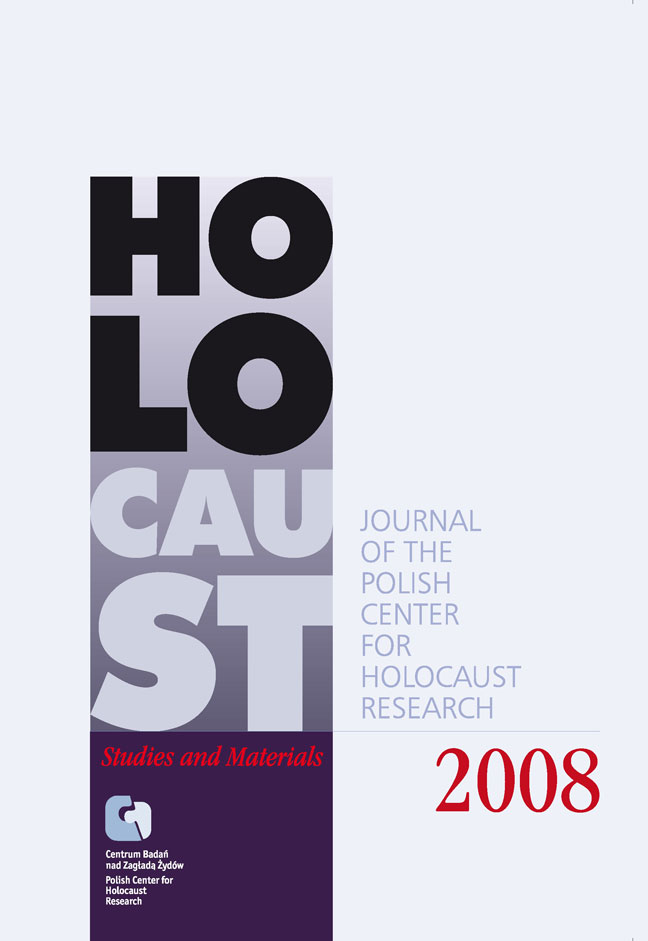Błoński’s Essay Years Later
Zagłada Żydów. Studia i Materiały, 2008, Strony: 23-30
Data zgłoszenia: 2020-09-25Data publikacji: 2008-12-01
 https://doi.org/10.32927/ZZSiM.55
https://doi.org/10.32927/ZZSiM.55
Abstrakt
The author reflects upon Jan Błoński’s essay “Biedni Polacy patrzą na getto” (Poor Poles look at the ghetto) nearly twenty years of its publication by Tygodnik Powszechny. He points at the innovative character of the depiction of Polish-Jewish issues in the moral context, outside of all the political embroilments. Błoński’s voice is unique, because it acknowledges, in the spirit of the Gospels, that analysis of Polish- -Jewish relations is a fundamental issue for the Polish society, a “homework” that needs to be done. This essay, Głowiński claims, is free from the embroilment in the dualism of the negative and positive myths regarding these relations. The author writes about reactions to this text, the letters to the editor and notes one particular voice, which he reads as an internalised nationalist ideology and the dangerous continuation of the nationalist discourse. Głowiński’s sketch concludes the post scriptum, in which the author refers to another article, published in 2006 by Gazeta Wyborcza, regarding the current historical policy, whose proponents see Błoński’s essay as a negative reference
point. The author notes that this essay constantly evokes strong emotions, and, as an expression of critical patriotism, still has its ardent opponents.
Licencja
Prawa autorskie (c) 2008 Autor & "Zagłada Żydów. Studia i Materiały"

Utwór dostępny jest na licencji Creative Commons Uznanie autorstwa 4.0 Międzynarodowe.
https://creativecommons.org/licenses/by/4.0
Inne teksty tego samego autora
- Michał Głowiński, Jan Błoński "Biedni Polacy patrzą na getto” w 20 lat później , Zagłada Żydów. Studia i Materiały: Nr 2 (2006)
- Michał Głowiński, Oczy donosiciela , Zagłada Żydów. Studia i Materiały: Nr 10 (2014)
- Michał Głowiński, Mordechaj Chaim Rumkowski – postać rzeczywista i bohater legend , Zagłada Żydów. Studia i Materiały: Nr 9 (2013)
- Michał Głowiński, Życiorys Batji Klig , Zagłada Żydów. Studia i Materiały: Nr 7 (2011)
Podobne artykuły
- Barbara Engelking, Pamiętnik dr. Chaima Einhorna , Zagłada Żydów. Studia i Materiały: Nr 11 (2015)
- Dariusz Libionka, Walka i propaganda. Powstanie w getcie warszawskim z perspektywy polskiego Londynu , Zagłada Żydów. Studia i Materiały: Nr 10 (2014)
- Jacek Leociak, “I don’t want people laughing at me for hiding Jews at my place . . .” The Case of Zdzisław and Halina Krzyczkowski , Zagłada Żydów. Studia i Materiały: 2010: Holocaust Studies and Materials
- Adam Puławski, „Benzyny zużyto 8 litrów”. Prozaizacja Zagłady na przykładzie dokumentacji Archiwum Państwowego w Lublinie Oddział w Chełmie , Zagłada Żydów. Studia i Materiały: Nr 14 (2018)
- Marnix Croes, Zagłada Żydów w Holandii a odsetek ocalałych , Zagłada Żydów. Studia i Materiały: Nr 4 (2008)
- David Silberklang, Józef Kermisz (1907–2005) – twórca badań nad Szoa , Zagłada Żydów. Studia i Materiały: Nr 10 (2014)
- Monika Polit, The Text Called Szmul Rozensztajn’s Diary , Zagłada Żydów. Studia i Materiały: 2008: Holocaust Studies and Materials
- Monika Polit, Tekst zwany 'Dziennikiem Szmula Rozensztajna' , Zagłada Żydów. Studia i Materiały: Nr 2 (2006)
- Barbara Engelking, „...Zupełnie zdani jesteśmy na nich...” Relacja ratujących z ukrywanymi na przykładzie dziennika Feli Fischbein , Zagłada Żydów. Studia i Materiały: Nr 4 (2008)
- Barbara Engelking, Notes by Jan Górnicki (Ber Oszer Weisbaum) , Zagłada Żydów. Studia i Materiały: Nr Holocaust Studies and Materials (2013)
<< < 1 2 3 4 5 6 7 8 9 10 11 12 13 14 15 16 17 18 19 20 21 22 23 24 25 26 27 28 29 30 31 32 33 34 35 36 37 38 39 40 41 42 43 44 45 46 47 48 49 50 > >>
Możesz również Rozpocznij zaawansowane wyszukiwanie podobieństw dla tego artykułu.
 English
English
 Język Polski
Język Polski








